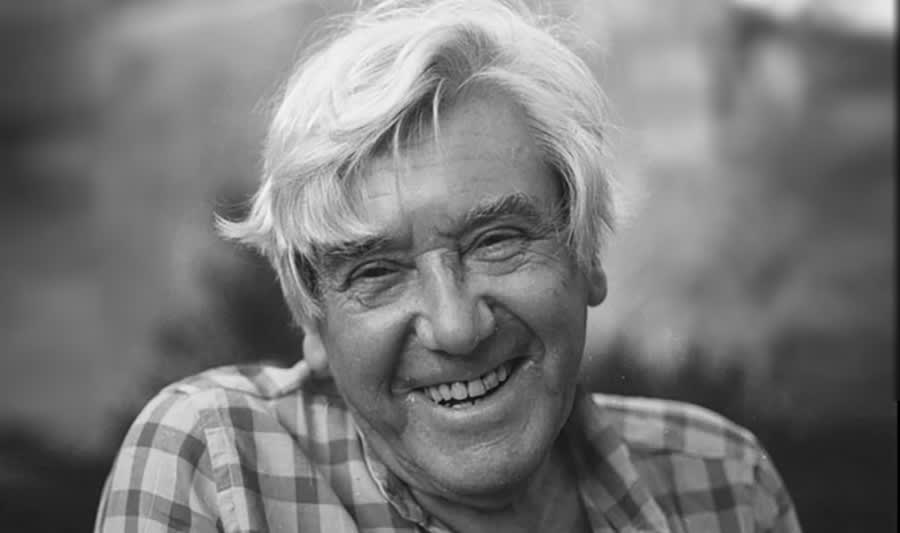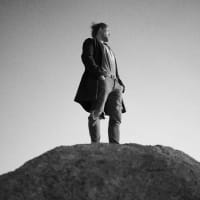
The Surrealist Movement
Matta relocated to Paris, France, in 1933 to serve renowned architect Le Corbusier. He visited Madrid, Spain, in 1934. Matta was acquainted with Salvador Dal, who urged him to exhibit André Breton his sketches.
Matta was linked to the Surrealist movement via Breton and Dal, which he embraced in 1937. Gordon Matta-Clark and Sebastian Matta-Clark, Matta's twin sons, were both painters. Ramuntcho Matta, his son, is a composer, and Federica Matta, his daughter, is a painter.
The Evolution and Controversies
Matta emigrated to New York City from Europe in 1938. His artistry evolved from sketches to oil paintings during this time, and it is for these, he is most renowned. The artist spent the following ten years in the United States, working on his inscape series.
Over a quarrel involving Arshile Gorky and his family, The group terminated matta's ties to the Surrealist movement. He was suspected of having an affair with Gorky's wife, which contributed to Gorky's suicide. Matta was expelled from the Surrealist movement due to this, but he had already earned a reputation for himself.
The Semi-Abstract Era
The artist split his work between South America and Europe into the 1950s and 1960s. His works mixed semi-abstract art with geopolitics. He liked to paint on large panels and painted a mural for Salvador Allende, Chile's president at the time, named "The First Goal of the Chilean People."
Matta's best-known works are the Road to Heaven, Redness of Blue, Wound Interrogation, The Prophet, Dark Light, Nude Hiding in the Forest, and La Terre Uni. Matta died in Civiavecchia, Italy, on November 23, 2002.
Roberto Matta: A Microscopic Look at His Life
Matta was half-Spanish, half-Basque, and half-French. He was born in Santiago and graduated in 1935 from the Pontificia Universidad Católica de Chile, where he studied architecture and interior design. He traveled from Peru to Panama that spring, creating fantastical sketches of many of the geographical characteristics he saw.
He served in the Merchant Marine after graduation, where he first saw Europe. Arshile Gorky, René Magritte, Salvador Dal, André Breton, and Le Corbusier were among the artists he met throughout his journeys in Europe and the United States.
Breton was the catalyst for the Chilean's artistic orientation, promoting his work and connecting him to prominent figures of the Paris Surrealist movement.
The Inscape Series
Matta's work blossomed for the first time in 1938 when he switched from drawing to oil painting, for which he is most known. This period corresponded to his immigration to the United States, where he remained until 1948. With diffused light designs and strong lines on an undecorated backdrop, his early works, such as Invasion of the Night, provide a glimpse of the work he would continue.
The "inscape" series and the closely related "psychological morphologies" were created during this period. According to Prof. Claude Cernuschi, Matta's main objective was to express and convey the human psyche in graphical format, which was mediated via Freud's writings and the psychoanalytic notion of the psyche as a three-dimensional space: the 'inscape.'
The Combination of Organic and Cosmic Lifeforms
According to an essay on Matta in Crosscurrents of Modernism, the inscapes' emotive shapes are visual metaphors for the artist's mind. During the 1940s and 1950s, Matta's art became increasingly dense with images of electrical gear and distraught humans, reflecting the troubling situation of international politics.
Clay was added to Matta's works in the early 1960s, giving the aberrations a new depth. Matta's work combines organic and cosmic lifeforms to create new realities. He was one of the first painters to venture into the realm of abstraction.
The Controversies and Falling Out with the Surrealist Movement
Following a private quarrel about Arshile Gorky and his wife, the group terminated matta's ties to Breton's surrealist movement. In reaction to Matta's involvement with the Armenian-American painter's spouse, Matta was accused of indirectly instigating Gorky's suicide.
Matta was kicked out of the organization due to this, but his name was already well-known. During the 1950s and 1960s, he split his time between Europe and South America, integrating political and semi-abstract elements in vast surreal paintings.
The Social Movements of the 1960s and 1970s
Matta thought that art and poetry had the power to improve people's lives, and he was active in social movements in the 1960s and 1970s. He was a firm advocate of President Salvador Allende's socialist regime in Chile. After the violent takeover of Salvador Allende in 1973, he created a mural named "The First Goal of the Chilean People" with over 16 layers of paint.
Local authorities found the painting in 2005. The artwork was repaired in 2008 for $43,000, and it is now on exhibit in the La Granja city hall in Santiago. Matta worked with various mediums during his life, including ceramics, photography, and video creation.
The Grand Finale
On November 23, 2002, Matta died eleven days after his 91st birthday in Civitavecchia, Italy. Patricia Matta Echaurren (née O'Connell), an American (who subsequently married Pierre Matisse), was Matta's first wife, and Germana Ferrari was his second.
He has a total of six children. Two of his children died young, leaving his artistic heritage to Gordon Matta-Clark and his twin brother Sebastian, Ramuntcho Matta, Federica Matta, designer Alisée, and writer Pablo Echaurren whose surname was incorrectly registered at birth.
Roberto Matta: The Artistic Legacy
Matta distinguished himself as one of the leading protagonists in the Surrealist movement over the course of a lengthy and profitable career spanning six decades and several geographies. While he had artistic and conceptual connections with the Surrealists, he could never fully integrate his profound social conscience with their inherently inward-looking techniques.
On the other hand, Matta matched his interest in the human mind with active participation in the outside world. He gave the Abstract Expressionists an early and vital influence in the process.
Matta's creative impact was also very personal since four of his six children went on to become well-known painters. The modern artist Gordon Matta-Clark, who followed in his father's legacy by making socially aware work with a particular architectural bent, is the most well-known of his offspring.
The Best Works
Roberto Matta, a Chilean-born artist, was a global personality whose vision was a blend of European, American, and Latin American cultures. Matta parted with both factions to follow a very individualized creative vision, having been a member of the Surrealist movement and an early teacher to numerous Abstract Expressionists.
In his later work, he used abstraction, figuration, and multidimensional spaces to create intricate, cosmic vistas. Matta's lengthy and illustrious career was marked by a strong social consciousness and a deep examination of his inner and outside worlds. Here are some of his top works:
- Sick Flesh (ca. 1932-1933)
- The Clown (1934)
- Panama and Wet Sheets (1936)
- The Red Sun, Space Travel (Star Travel), To Both of You, Crucifiction (Croix Fiction), several works titled Psychological Morphology and Morphology of Desire (1938)
- Invasion of the Night, Ecouter Vivre, Théorie de l’Arbre, Composition Abstraite, The Initiation (Origine d’un Extrême) and Foeu (1941)
- Wound Interrogation and The Prophet (1948)
- Le plus libre (1952)
- Morning on Earth, Hills a Poppin, The Murder of the Rosenbergs, L’Hosticier and L’Apetite de Primer (1953)
- Abrir los Brazos Como se Abren los Ojos, Bud Sucker, The Chess Player, L’Atout and Tados Juntos en la Tierra (1954)
- Le Long Pont, Spearcing of the Grain, L’Engin dans l’Éminence and Intervision (1955)
- Un Soleil à Qui Sait Reunir, Les Faiseurs du Neant, Gay Above All, The Clan and L’Impensable (Grand Personage) (1959)
- Vivir Enfrentando las Flechas (1961)
- Les Moyens du Creafeur, Claustrophobic Vaincue and Mal de Terre (1962)
- Éros Semens (triptych, started in 1962) and La Luz del Proscrito (started in 1963) (1964)
- La Térre Uni (1965)
- Le où A Marée Haute and La Promenade de Vénus (1966)
- Signe of the Times and Morire per Amore (1967)
- Malitte (modular furniture set designed between 1966 and 1968) and La Caza de Adolescentes (1968)
- Elle Logela Folie, Je-ographie, El Hombre de la Lampara and MAgriTTA Chair (1970)
- Otto Por Tre, El primer gol del pueblo chileno and Paralelles de la Viel (1971)
- La Vida Allende la Muerte, Senile d’Incertitude, Migration des Révoltes and Hom’mer (Chaosmos) (suite of ten etchings with aquatint) (1973)
- Explosant Fixe, Je M’Espionne, Deep Mars, L’Aube Permanente and Cadran d’Incendies (1974)
- Mas Ceilin and Illumine le Temps (1975)
- Rooming Life, L’Ombre de l’Invisible and Ouvre l’Instant (1977)
- Carré-four and Dedalopolous (1978)
- Il Proprio Corno Mio, Laocoontare (La Guerra Delle Idee) and Pyrocentre (1980)
- Las Scillabas de Scylla, El Espejo de Cronos and El Verbo América (1981)
- Geomagnética de Danza (started in 1981), Ils Sexplose, Passo Interno di Mercurio, Labirintad and The Sign (1982)
- Ecran de la Mémoire and Le Dauphin de la Memoire (1984)
- L'Espace Du Point (1985)
- Mi-mosa, 24 Mai 1986, Une Pierre Qui Regagnera le Ciel and Oeramen, la Conscience est un Arbre Vetroresina (1986)
- Violetation and L’Envenement Non Identifié (1989)
- A l’Intérieur de la Rose, Omnipuissance du Rouge, Navigateur and Haiku (1990)
- Parmi les Désirs and Ma Dame (1991)
- Leaving Your Grass, Vertige du Vertige, Torinox and Colomberos (1993)
- Vent d’Atomes (1994)
- Les Arpèges, L’Âme du Fond and Melodia-Melodio (1995)
- The Road to Heaven, Storming Water River and Redness of Blue (1996)
- Flowerita and Oak Flower (1997)
- N’ou’s Autres (2000)
- Chaosmos (2002), Viersen sculpture collection
- Post History Chicken Flowers, La Dulce Acqua Vita, and La Source du Calme (2002)
Roberto Matta: The Visionary Genius Who Combined Abstraction and Surrealism
Roberto Matta was a Chilean artist noted for fusing Surrealism with Abstract Expressionism in a distinctive manner. Matta's fantastical paintings and prints, like those of his friend Arshile Gorky, investigated the subconscious through Surrealist automatism.
As seen in the signature work Les Roses sont belles, the artist portrayed ethereal realms populated by floating organic and architectural shapes with flowing brushstrokes of rich color.
Matta moved to New York in 1938, started painting in oil, and befriended American artists while keeping in touch with European friends like Yves Tanguy. He died on November 23, 2002, at the age of 91, in Civitavecchia, Italy.
The Tate Gallery in London, the Museum of Modern Art in New York, the Walker Art Center in Minneapolis, and the Peggy Guggenheim Collection in Venice all include Matta's work in their archives.
ROBERTO MATTA: A BRIEF OVERVIEW
A BRIEF TIMELINE
- 1911: Born in Santiago, Chile
- 1928: Worked as an interior decorator, Santiago, Chile
- 1929-1931: Studied architecture, Catholic University, Santiago, Chile
- 1933: Worked as a merchant seaman, Compagnie Transatlantique ship, to Europe
- 1934-1936: Worked as an architectural assistant, Le Corbusier studio, Paris, France
- 1937: On invitation by Andre Breton, joined the Surrealist group
- 1934-1939: Lived in Paris, France
- 1937-1948: Member, with Federico Garcia Lorca, André Breton, Salvador Dali, Marcel Duchamp, Surrealist Group Paris, France
- 1939-1948: Lived in New York, USA
- 1950-1954: Lived in Rome, Italy
- 1955: Moved to Paris, France
- 1962: Awarded Premio Marzotto, Rome, Italy
- 1966: Visiting Instructor at School of Art, Minneapolis, USA
- 1968: President, Cultural Congress, Havana, Cuba
- 1972: Founder, Etrusculudens, Etruscan crafts artisan group
- 2002: Died: Civitavecchia, Italy

